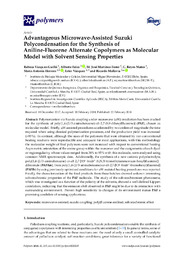Resumen :
Polymerization via Suzuki coupling under microwave (_W) irradiation has been studied
for the synthesis of poly{1,4-(2/3-aminobenzene)-alt-2,7-(9,9-dihexylfluorene)} (PAF), chosen as
molecular model. Briefly, _W-assisted procedures accelerated by two orders of magnitude the time
required when using classical polymerization processes, and the production yield was increased
(>95%). In contrast, although the sizes of the polymers that were obtained by non-conventional
heating reactions were reproducible and adequate for most applications, with this methodology
the molecular weight of final polymers were not increased with respect to conventional heating.
Asymmetric orientation of the amine group within the monomer and the assignments of each dyad
or regioregularity, whose values ranged from 38% to 95% with this molecule, were analysed using
common NMR spectroscopic data. Additionally, the synthesis of a new cationic polyelectrolyte,
poly{1,4-(2/3-aminobenzene)-co-alt-2,7-[9,9´-bis(6”-N,N,N-trimethylammonium-hexyl)fluorene]}
dibromide (PAFAm), from poly{1,4-(2/3-aminobenzene)-co-alt-2,7-[9,9´-bis(6”-bromohexyl)fluorene]}
(PAFBr) by using previously optimized conditions for _W-assisted heating procedures was reported.
Finally, the characterization of the final products from these batches showed unkown interesting
solvatochromic properties of the PAF molecule. The study of the solvatochromism phenomena,
which was investigated as a function of the polarity of the solvents, showed a well-defined Lippert
correlation, indicating that the emission shift observed in PAF might be due to its interaction with
surrounding environment. Proven high sensitivity to changes of its environment makes PAF a
promising candidate of sensing applications.
|
 La licencia se describe como: Atribución-NonComercial-NoDerivada 4.0 Internacional.
La licencia se describe como: Atribución-NonComercial-NoDerivada 4.0 Internacional.
.png)
